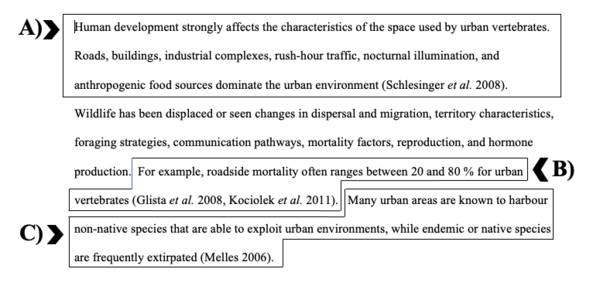Even the most well-researched piece of science writing will fail to make an impact if it is not easy to read and interpret. The trick to organizing your writing is to develop a writing outline before you put pen to paper (or fingers to keyboard). More information on outlines can be found on our outlining resource.
There are three key things that you can focus on to make sure that your writing is well organized. Firstly, you can split it into paragraphs based on content. Secondly, you can write effective topic sentences to kick off each paragraph with, and thirdly, you can ensure each sentence flows smoothly into the next by making sure your transitions are well chosen.
Paragraphs
Paragraphs are extremely important components of an effectively structured piece of writing because they organize material in a way that makes it easier to follow for your readers. Structuring your writing into clear, effective paragraphs that address individual ideas will help you organize your work, which in turn gives your readers the best possible chance of understanding the points you are trying to make.
Here are some strategies for writing clear paragraphs:
- Have a clear topic sentence. Make sure that the first sentence of your paragraph clearly captures the main point of your paragraph. This establishes the topic of the paragraph and sets up the readers expectations.
- Provide evidence to fully support the main point. Each sentence in the paragraph should expand upon or support the topic sentence.
- The relationship between the topic sentence and the concluding sentence should be clear. If not, it is possible that the purpose of the paragraph may have changed midway through. If this happens, consider rewriting the topic sentence to reflect what the paragraph actually does, or breaking the paragraph into smaller parts.
Transitions
a) Have a clear topic sentence. Make sure that the first sentence of your paragraph clearly captures the main point of your paragraph. This establishes the topic of the paragraph and sets up the reader's expectations.
- In the example excerpted from Garber (2012) below, the first sentence of the paragraph is the topic sentence. This sentence clearly introduces the topic and establishes what is going to be discussed throughout the paragraph (i.e., how human development impacts various aspects of the environment that “urban vertebrates” use.)
b) Provide evidence to fully support the main point. Each sentence in the paragraph should expand upon or support the topic sentence.
- In the excerpt below, the author uses an example to provide concrete evidence to support the main point of the paragraph.
c) The relationship between the topic sentence and the concluding sentence should be clear. If not, it is possible that the purpose of the paragraph may have changed midway through. If this happens, consider rewriting the topic sentence to reflect what the paragraph actually does, or breaking the paragraph into smaller parts
- In the particular example below, the author concludes the paragraph by clearly connecting back to and emphasizing the initial point in the first sentence.
Figure 1. Adapted from Philipp Garber, Urban Vertebrate Ecology of the Pacific Northwest, with Recommendations for Wildlife Stewardship at UBC Vancouver (Vancouver: University of British Columbia, 2012). http://dx.doi.org/10.14288/1.0108522.
References
Garber, Philipp. 2012. “Urban Vertebrate Ecology of the Pacific Northwest, with Recommendations for Wildlife Stewardship at UBC Vancouver.” R. UBC Social Ecological Economic Development Studies (SEEDS) Student Reports (Undergraduate). December 18. doi:http://dx.doi.org/10.14288/1.0108522.
Further reading:

